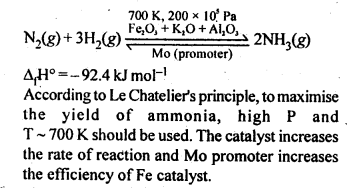

Mention the conditions required to maximise the yield of ammonia.
Ammonia is prepared by Haber’s process as given below:

Match the formulas of oxides given in Column I with the type of oxide given in Column II and mark the correct option.

Write balanced equations for the following:
(i) NaCl is heated witlrsulphuric acid in the presence of MnO2
(ii) Chlorine gas is passed into a solution of Nal in water.
How is nitrogen prepared in the laboratory? Write the chemical equations of the reactions . involved.
What happens when sulp’hur dioxide is passed through an aqueous solution of Fe(III) salt?
Which of the following acid forms three series of salts?
(a) H2PO2 (b) H3BO3 (C)H3PO4(d)H3PO3
Which of the following statements are true?
(a) Only type of interactions between particles of noble gases are due to weak dispersion forces.
(b) Ionisation enthalpy of.molecular oxygen is very close to that of xenon.
(c) Hydrolysis of XeF6 is a redox reaction.
(d) Xenon fluorides are not reactive.
Why does nitrogen show catenation properties less than phosphorus ? (C.B.S.E. Foreign 2009)
What happens when white phosphorus is heated with concentrated NaOH solution in an inert atmosphere of CO2 ?
If chlorine gas is passed through hot NaOH solution, two changes are observed in the oxidation number of chlorine during the reaction. These are —— and ——-
Which of the following statements are correct?
(a) All three N – O bond lengths in HNO3 are equal.
(b) All P – Cl bond lengths in PCl5 molecule in gaseous state are equal.
(c) P4 molecule in white phosphorus have angular strain therefore white phosphorus is very reactive.
(d) PCl5 is ionic in solid state in which cation is tetrahedral and anion is octahedral.
How is nitrogen prepared in the laboratory? Write the chemical equations of the reactions . involved.
What happens when sulp'hur dioxide is passed through an aqueous solution of Fe(III) salt?
The HNH angle value is higher than HPH, H AsH and HSbH angles. Why?
(Hint: Can be explained on the basis of sp3 hybridisation in NH3 and only s-p bonding , between hydrogen and other elements of the group).
What are the oxidation states of phosphorus in the following: –
(i) H3PO3 (ii)PCl3
(iii) Ca3P2(iv)Na3PO4
(v) POF3
Bond dissociation enthalpy of E – H (E = element) bonds is given below. Which of the compounds will act as strongest reducing agent?

Which of the following options are not in accordance with the properly mentioned against them?

Nitric acid forms an oxide of nitrogen on reaction with P4O10. Write the reaction involved. Also write the resonating structures of the oxide of nitrogen formed.
Assertion (A): SF6 cannot be hydrolysed but SF4 can be.
Reason (R): Six F atoms in SF6 prevent the attack of H2O on sulphur atom of SF6.
Why is BiH3 the strongest reducing agent amongst all the hydrides of group 15 elements? (C.B.S.E. 2013)
Considering the parameters such as bond dissociation enthalpy, electron gain enthalpy and hydration enthalpy, compare the oxidising powers of F2 and Cl2.